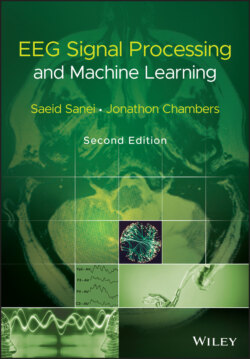Читать книгу EEG Signal Processing and Machine Learning - Saeid Sanei - Страница 13
1 Introduction to Electroencephalography 1.1 Introduction
ОглавлениеThe brain is the most amazing and complicated part of the human body and is responsible for controlling all other organs. The neural activity of the human brain starts between the seventeenth and twenty‐third week of prenatal development. It is believed that from this early stage and throughout life electrical signals generated by the brain represent not only the brain function but also the status of the whole body. This assumption provides the motivation to study and understand the range of brain activities including normal brain rhythms, brain responses to stimuli, brain motor generators, and finally brain connectivity. One or more of these activities change in cases of brain disorder, disease, or abnormality. The brain status and often the entire body condition can then be recognized by applying advanced digital signal processing and machine learning methods to the electroencephalography (EEG) signals measured from the brain, and thereby underpin the later chapters of this book.
Although nowhere in this book do the authors attempt to comment on the physiological aspects of brain activities, there are several issues related to the nature of the original sources, their actual patterns, and the characteristics of the medium, that have to be addressed. The medium defines the path from the neurons, so‐called signal sources, to the electrodes, which are the sensors where some form of mixtures of the sources (for the case of scalp electrodes) or individual sources (e.g. for subdural electrodes) are measured.
Understanding of neuronal functions and neurophysiological properties of the brain together with the mechanisms underlying the generation of signals and their recordings is however, vital for those who deal with these signals for detection, diagnosis, and treatment of brain disorders and the related diseases.
Examining brain activity or abnormality, however, is not limited to the use of EEG. For the abnormalities which affect the brain structure, different radiographical methods can be used. Also, for detecting the brain functional abnormalities, which is the main agenda for activity detection and functional monitoring, magnetoencephalography (MEG) and functional magnetic resonance imaging (fMRI) may be used. However, MEG is expensive and not readily accessible, and fMRI has very low temporal resolution and is not widely available. Therefore, EEG remains the main functional brain scanning modality as it is cheap, portable, and widely available.
We begin by providing a brief history of EEG measurements and looking at the journey from the time the brain function was initially recognized to the current time when new techniques in data processing, machine learning, and artificial intelligence have become popular research focuses.
